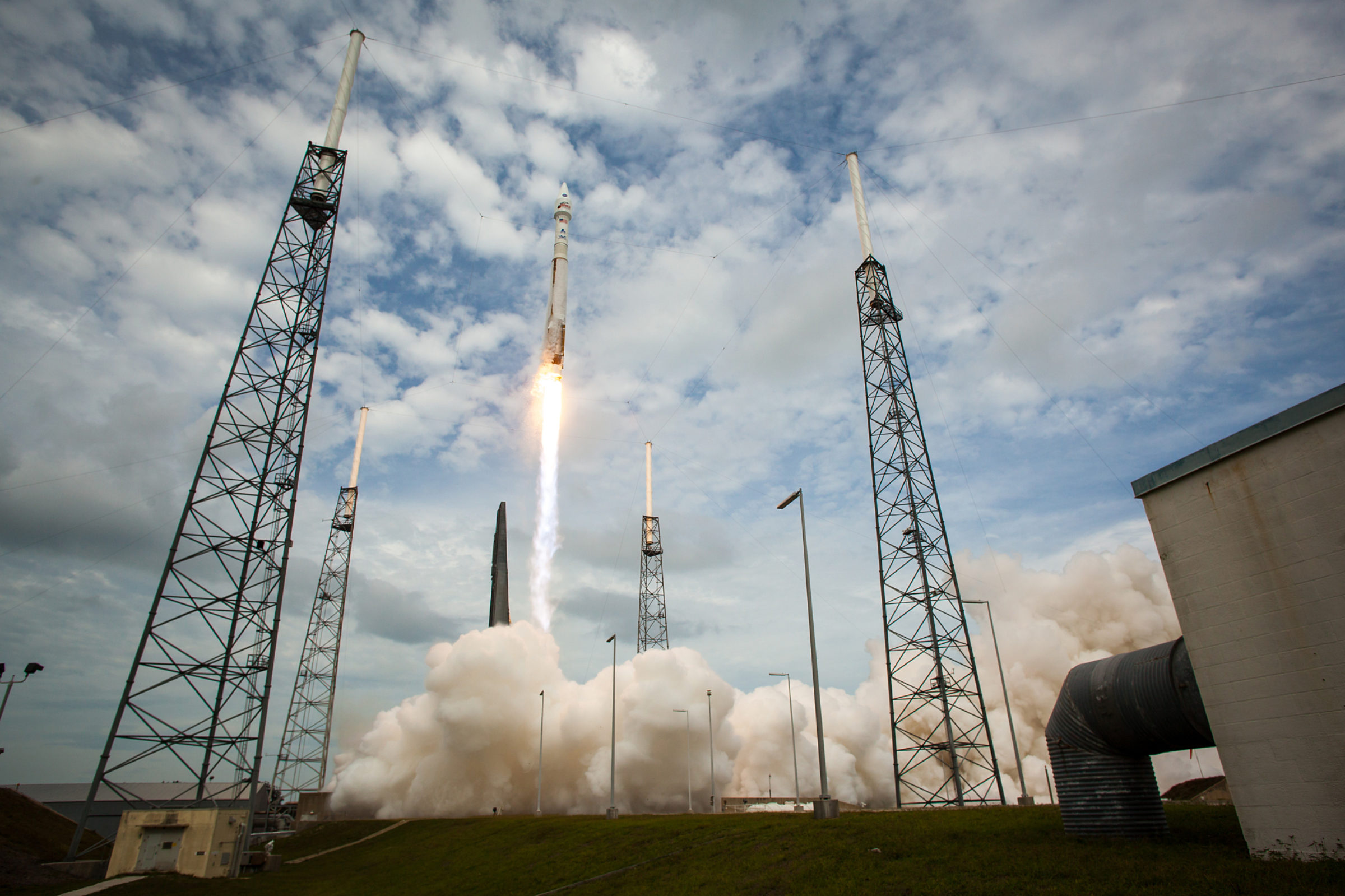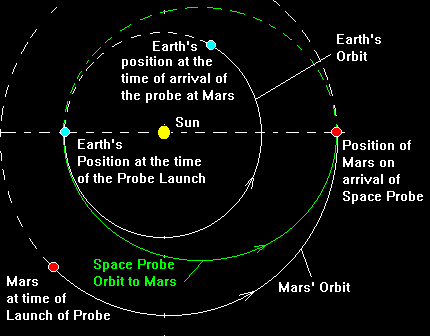Emily Lakdawalla • Nov 22, 2013
Why are MAVEN and Mars Orbiter Mission taking such different paths to Mars?
Editor's note, Sept 23, 2014: want to follow Mars Orbiter Mission's Mars arrival live? Here's a timeline with links to live video. Best of luck to ISRO! --Emily Lakdawalla
Two spacecraft launched for Mars this month: Mars Orbiter Mission on November 5, and MAVEN on November 18. But MAVEN is already on an interplanetary trajectory, while Mars Orbiter Mission is still in Earth orbit and will not depart for Mars until the end of the month. A lot of people are asking me: why the difference?
I knew it was related to their different launch vehicles, but to get a more informed answer I turned to David Doody, a senior engineer at the Jet Propulsion Laboratory and author of the really awesome JPL online resource called "The Basics of Space Flight." Dave periodically teaches courses on how interplanetary navigation works; registration opens in April for his next one.
Dave confirmed that the different approaches were related to their launch vehicles and to the different spacecraft masses. For MAVEN, the trip to Mars is straightforward. That's because its Atlas V rocket was able to deliver both MAVEN (with a mass of 2500 kilograms, fully fueled) and an attached, powerful Centaur upper stage into Earth orbit. While already orbiting Earth, Centaur was able to kick MAVEN directly on to Mars. Dave explained:
On Monday the MAVEN spacecraft, stacked atop a Centaur upper stage, enjoyed a flawless launch, rising from Earth on an Atlas 5. The Centaur fired its engine to place itself and the spacecraft into a more or less circular Earth orbit. After twenty-seven minutes, it had coasted around to just the right point to start the trip to Mars: tangent to Earth's solar orbit on the midnight side. There the Centaur fired again, injecting it into its interplanetary trajectory. The spacecraft then separated from the Centaur and deployed its solar panels for cruise. (This is a familiar sequence, by the way. The Cassini spacecraft started out from Earth using two burns from its Centaur.) From here to Mars, it's just a long coasting free-fall, with the exception of a few very brief propulsive events to make trajectory corrections as needed.


India's four-stage Polar Satellite Launch Vehicle (PSLV) could deliver Mars Orbiter Mission (with a mass of 1340 kilograms, fully fueled) to Earth orbit, but not with a heavy, powerful upper stage like Centaur. Mars Orbiter Mission has to get to Mars using its much smaller Liquid Apogee Motor (LAM) and the relatively small amount of fuel it was able to carry to orbit. Dave explained:
MOM chooses to do things differently. Having less massive a spacecraft than MAVEN, ISRO is depending on its proven Polar Satellite Launch Vehicle, and a reliable propulsion system that is built into the spacecraft: a 440-newton bi-propellant fed rocket engine (Cassini has biprop 440 N engines too!), and instead of one very powerful Centaur burn (about 99,000 newtons), ISRO would use its much smaller engine repeatedly. It has to be repeated burns, rather than one long burn, because in order to raise the spacecraft's apoapsis - the high point in its orbit - it has to fire when it is speeding past its closest point to Earth, at periapsis. (For more details on this, look for "The Key to Space Flight" here.)
So with repeated burns while going through periapses, the MOM spacecraft is working its way to a high enough energy to get on a trajectory that will be hyperbolic with respect to Earth; it will have the ability to inject onto its interplanetary cruise, orbiting the Sun instead of Earth. MAVEN did this all at once with a powerful rocket; MOM is doing it in steps using its smaller rocket, but the energy required (per unit of spacecraft mass) is about the same.
It took about five minutes of thrust from the Centaur for MAVEN to depart Earth orbit for its interplanetary transfer. I counted up the rocket burns reported for Mars Orbiter Mission so far, and they amounted to roughly 40 minutes' total thrust. (They didn't report times for every burn, so this is just an estimate.) Those minutes were spread out over six maneuvers, all timed to happen right when the spacecraft was near its perigee, to make the most of their precious fuel. One more burn remains, the largest one yet by far, to send Mars Orbiter Mission on to Mars. ISRO chief K. Rhadakrishnan stated the statistics in an interview to The Hindu earlier this week:
In the early hours of December 1, around 00.36 hours [IST, or November 30 at 11:06 PT / 19:06 UT], we have the trans-Mars injection of our Mars spacecraft. On that day, we are going to use the 440 Newton liquid engine again to impart a delta-v, that is, an incremental velocity of nearly 648 metres a second to the spacecraft and the engine will burn for 1,351 seconds.... When this running of the 440 Newton liquid engine takes place on December 1, we also have eight numbers of 22 Newton control thrusters firing.
Once Mars Orbiter Mission has left Earth orbit, its trajectory toward Mars will be very similar to MAVEN's, Dave explained:
After their Earth departures, MAVEN on November 18 and MOM planned for November 30, their interplanetary trajectory will be the well-known, minimum propellant, Hohmann Transfer, in which they coast "up" away from the Sun, slowing all the way to Mars. Upon arrival, each spacecraft will again fire its rocket engine to be captured by Mars's gravity and enter orbit around the planet.

Both spacecraft get only one chance to enter Mars orbit. Mars Orbiter Mission will again be using its single 440-Newton rocket to perform the orbit insertion maneuver. MAVEN has six rocket motors, each of which can achieve 200 Newtons of thrust. But MAVEN needs that much more power, because it is a much heavier spacecraft. When MAVEN arrives at Mars, it will still possess nearly all the fuel it launched with, and will weigh in at around 2400 kilograms. Mars Orbiter Mission will have burned a great deal of its onboard fuel simply to depart Earth orbit, so will weigh under 1000 kilograms.
| Mars Orbiter Mission | MAVEN | |
|---|---|---|
| Launch mass | 1340 kg | 2454 kg |
| Propellant | 852 kg | 1645 kg |
| Dry mass | 488 kg | 809 kg |
I highly recommend the Basics of Space Flight as a well-explained resource on how we get spacecraft from one place to another!
Support our core enterprises
Your support powers our mission to explore worlds, find life, and defend Earth. You make all the difference when you make a gift. Give today!
Donate

 Explore Worlds
Explore Worlds Find Life
Find Life Defend Earth
Defend Earth


